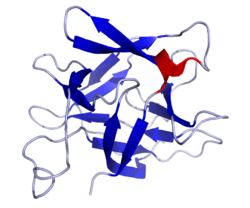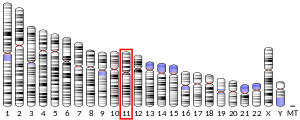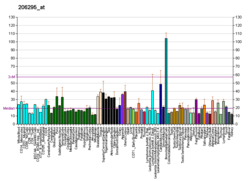Interleukin 18
Interleukin-18 (IL18, also known as interferon-gamma inducing factor) is a protein which in humans is encoded by the IL18 gene.[5][6] The protein encoded by this gene is a proinflammatory cytokine. Many cell types, both hematopoietic cells and non-hematopoietic cells, have the potential to produce IL-18. It was first described in 1989 as a factor that induced interferon-γ (IFN-γ) production in mouse spleen cells.[7] Originally, IL-18 production was recognized in Kupffer cells, liver-resident macrophages. However, IL-18 is constitutively expressed in non-hematopoietic cells, such as intestinal epithelial cells, keratinocytes, and endothelial cells.[8] IL-18 can modulate both innate and adaptive immunity and its dysregulation can cause autoimmune or inflammatory diseases.[9][10]
Processing
Cytokines usually contain the signal peptide which is necessary for their extracellular release. In this case, IL18 gene, similar to other IL-1 family members, lacks this signal peptide.[11] Furthermore, similar to IL-1β, IL-18 is produced as a biologically inactive precursor. IL-18 gene encodes for a 193 amino acids precursor, first synthesized as an inactive 24 kDa precursor with no signal peptide, which accumulates in cell cytoplasm. Similarly to IL-1β, the IL-18 precursor is processed intracellularly by caspase 1 in the NLRP3 inflammasome into its mature biologically active molecule of 18 kDa.[12]
Receptor and signaling
IL-18 receptor consists of the inducible component IL-18Rα, which binds the mature IL-18 with low affinity and the constitutively expressed co-receptor IL-18Rβ. IL-18 binds the ligand receptor IL-18Rα, inducing the recruitment of IL-18Rβ to form a high affinity complex, which signals through the toll/interleukin-1 receptor (TIR) domain. This signaling domain rectruits MyD88 adaptor protein that activates proinflammatory programes and NF-κB pathway. The activity of IL-18 can be suppressed by extracellular interleukin 18 binding protein (IL-18BP) that binds soluble IL-18 with a higher affinity than IL-18Rα thus prevents IL-18 binding to IL-18 receptor.[13][14] IL-37 is another endogenous factor that suppresses the action of IL-18. IL-37 has high homology with IL-18 and can bind to IL-18Rα, which then forms a complex with IL-18BP, thereby reduces the activity of IL-18.[15] Moreover, IL-37 binds to single immunoglobulin IL-1 receptor related protein (SIGIRR), also known as IL-1R8 or TIR8, which forms a complex with IL-18Rα and induces an anti-inflammatory response. The IL-37/IL-18Rα/IL-1R8 complex activates the STAT3 signaling pathway, decreases NF-κB and AP-1 activation and reduces IFNγ production. Thus, IL-37 and IL-18 have opposing roles and IL-37 can modulate pro-inflammatory effects of IL-18.[16][17]
Function
IL-18 belongs to the IL-1 superfamily and is produced mainly by macrophages but also other cell types, stimulates various cell types and has pleiotropic functions. IL-18 is a proinflammatory cytokine that facilitates type 1 responses. Together with IL-12, it induces cell-mediated immunity following infection with microbial products like lipopolysaccharide (LPS). IL-18 in combination with IL12 acts on CD4, CD8 T cells and NK cells to induce IFNγ production, type II interferon that plays an important role in activating the macrophages or other cells. The combination of this IL-18 and IL-12 has been shown to inhibit IL-4 dependent IgE and IgG1 production and enhance IgG2a production in B cells.[18] Importantly, without IL-12 or IL-15, IL-18 does not induce IFNγ production, but plays an important role in the differentiation of naive T cells into Th2 cells and stimulates mast cells and basophils to produce IL-4, IL-13, and chemical mediators such as histamine.[19]
Clinical significance
Apart from its physiological role, IL-18 is also able to induce severe inflammatory reactions, which suggests its role in certain inflammatory disorders.
Endometrial IL-18 receptor mRNA and the ratio of IL-18 binding protein to interleukin 18 are significantly increased in adenomyosis patients in comparison to normal people, indicating a role in its pathogenesis.[20]
IL-18 has been implicated as an inflammatory mediator of Hashimoto's thyroiditis, the most common cause of autoimmune hypothyroidism. IL-18 is up regulated by interferon-gamma.[21]
IL-18 has also been found to increase the Alzheimer's disease-associated amyloid-beta production in human neuron cells.[22]
IL-18 is also associated with urine protein excretion what means that it can be marker for assessing the progression of diabetic nephropathy.[23][24] This interleukin was also significantly elevated in patients with microalbuminuria and macroalbuminuria when it was compared with healthy people and patients with diabetes which have normoalbuminuria.[25]
References
- GRCh38: Ensembl release 89: ENSG00000150782 - Ensembl, May 2017
- GRCm38: Ensembl release 89: ENSMUSG00000039217 - Ensembl, May 2017
- "Human PubMed Reference:". National Center for Biotechnology Information, U.S. National Library of Medicine.
- "Mouse PubMed Reference:". National Center for Biotechnology Information, U.S. National Library of Medicine.
- Okamura H, Tsutsi H, Komatsu T, Yutsudo M, Hakura A, Tanimoto T, et al. (November 1995). "Cloning of a new cytokine that induces IFN-gamma production by T cells". Nature. 378 (6552): 88–91. Bibcode:1995Natur.378...88O. doi:10.1038/378088a0. PMID 7477296.
- Nolan KF, Greaves DR, Waldmann H (July 1998). "The human interleukin 18 gene IL18 maps to 11q22.2-q22.3, closely linked to the DRD2 gene locus and distinct from mapped IDDM loci". Genomics. 51 (1): 161–3. doi:10.1006/geno.1998.5336. PMID 9693051.
- Nakamura K, Okamura H, Wada M, Nagata K, Tamura T (February 1989). "Endotoxin-induced serum factor that stimulates gamma interferon production". Infection and Immunity. 57 (2): 590–5. PMC 313137. PMID 2492265.
- Yasuda K, Nakanishi K, Tsutsui H (February 2019). "Interleukin-18 in Health and Disease". International Journal of Molecular Sciences. 20 (3): 649. doi:10.3390/ijms20030649. PMC 6387150. PMID 30717382.
- Baker KJ, Houston A, Brint E (2019). "IL-1 Family Members in Cancer; Two Sides to Every Story". Frontiers in Immunology. 10: 1197. doi:10.3389/fimmu.2019.01197. PMC 6567883. PMID 31231372.
- Fabbi M, Carbotti G, Ferrini S (April 2015). "Context-dependent role of IL-18 in cancer biology and counter-regulation by IL-18BP". Journal of Leukocyte Biology. 97 (4): 665–75. doi:10.1189/jlb.5RU0714-360RR. PMID 25548255.
- Dinarello CA, Novick D, Puren AJ, Fantuzzi G, Shapiro L, Mühl H, et al. (June 1998). "Overview of interleukin-18: more than an interferon-gamma inducing factor". Journal of Leukocyte Biology. 63 (6): 658–64. doi:10.1002/jlb.63.6.658. PMID 9620656.
- Gu Y, Kuida K, Tsutsui H, Ku G, Hsiao K, Fleming MA, et al. (January 1997). "Activation of interferon-gamma inducing factor mediated by interleukin-1beta converting enzyme". Science. 275 (5297): 206–9. doi:10.1126/science.275.5297.206. PMID 8999548.
- Dinarello CA (September 1999). "Interleukin-18". Methods. 19 (1): 121–32. doi:10.1006/meth.1999.0837. PMID 10525448.
- Kaplanski G (January 2018). "Interleukin-18: Biological properties and role in disease pathogenesis". Immunological Reviews. 281 (1): 138–153. doi:10.1111/imr.12616. PMID 29247988.
- Jia H, Liu J, Han B (2018). "Reviews of Interleukin-37: Functions, Receptors, and Roles in Diseases". BioMed Research International. 2018: 3058640. doi:10.1155/2018/3058640. PMC 5899839. PMID 29805973.
- Garlanda C, Anders HJ, Mantovani A (September 2009). "TIR8/SIGIRR: an IL-1R/TLR family member with regulatory functions in inflammation and T cell polarization". Trends in Immunology. 30 (9): 439–46. doi:10.1016/j.it.2009.06.001. PMID 19699681.
- Jia H, Liu J, Han B (2018). "Reviews of Interleukin-37: Functions, Receptors, and Roles in Diseases". BioMed Research International. 2018: 3058640. doi:10.1155/2018/3058640. PMC 5899839. PMID 29805973.
- "Entrez Gene: IL18 interleukin 18 (interferon-gamma-inducing factor)".
- Yasuda K, Nakanishi K, Tsutsui H (February 2019). "Interleukin-18 in Health and Disease". International Journal of Molecular Sciences. 20 (3): 649. doi:10.3390/ijms20030649. PMID 30717382.
- Huang HY, Yu HT, Chan SH, Lee CL, Wang HS, Soong YK (June 2010). "Eutopic endometrial interleukin-18 system mRNA and protein expression at the level of endometrial-myometrial interface in adenomyosis patients". Fertility and Sterility. 94 (1): 33–9. doi:10.1016/j.fertnstert.2009.01.132. PMID 19394601.
- Liu Z, Wang H, Xiao W, Wang C, Liu G, Hong T (October 2010). "Thyrocyte interleukin-18 expression is up-regulated by interferon-γ and may contribute to thyroid destruction in Hashimoto's thyroiditis". International Journal of Experimental Pathology. 91 (5): 420–5. doi:10.1111/j.1365-2613.2010.00715.x. PMC 3003839. PMID 20586818.
- Sutinen EM, Pirttilä T, Anderson G, Salminen A, Ojala JO (August 2012). "Pro-inflammatory interleukin-18 increases Alzheimer's disease-associated amyloid-β production in human neuron-like cells". Journal of Neuroinflammation. 9: 199. doi:10.1186/1742-2094-9-199. PMC 3458954. PMID 22898493.
- Liu F, Guo J, Zhang Q, Liu D, Wen L, Yang Y, et al. (2015-10-30). "The Expression of Tristetraprolin and Its Relationship with Urinary Proteins in Patients with Diabetic Nephropathy". PLOS ONE. 10 (10): e0141471. Bibcode:2015PLoSO..1041471L. doi:10.1371/journal.pone.0141471. PMC 4627660. PMID 26517838.
- Nakamura A, Shikata K, Hiramatsu M, Nakatou T, Kitamura T, Wada J, et al. (December 2005). "Serum interleukin-18 levels are associated with nephropathy and atherosclerosis in Japanese patients with type 2 diabetes". Diabetes Care. 28 (12): 2890–5. doi:10.2337/diacare.28.12.2890. PMID 16306550.
- Zhang D, Ye S, Pan T (2019-06-11). "The role of serum and urinary biomarkers in the diagnosis of early diabetic nephropathy in patients with type 2 diabetes". PeerJ. 7: e7079. doi:10.7717/peerj.7079. PMC 6568248. PMID 31218128.
Further reading
- Biet F, Locht C, Kremer L (March 2002). "Immunoregulatory functions of interleukin 18 and its role in defense against bacterial pathogens". Journal of Molecular Medicine. 80 (3): 147–62. doi:10.1007/s00109-001-0307-1. PMID 11894141.
- Nakanishi K (February 2002). "[Regulation of Th1 and Th2 immune responses by IL-18]". Kekkaku. 77 (2): 87–93. PMID 11905033.
- Reddy P, Ferrara JL (June 2003). "Role of interleukin-18 in acute graft-vs-host disease". The Journal of Laboratory and Clinical Medicine. 141 (6): 365–71. doi:10.1016/S0022-2143(03)00028-3. PMID 12819633.
- Kanai T, Uraushihara K, Totsuka T, Okazawa A, Hibi T, Oshima S, et al. (June 2003). "Macrophage-derived IL-18 targeting for the treatment of Crohn's disease". Current Drug Targets. Inflammation and Allergy. 2 (2): 131–6. doi:10.2174/1568010033484250. PMID 14561165.
- Matsui K, Tsutsui H, Nakanishi K (December 2003). "Pathophysiological roles for IL-18 in inflammatory arthritis". Expert Opinion on Therapeutic Targets. 7 (6): 701–24. doi:10.1517/14728222.7.6.701. PMID 14640907.
- Yoshimoto T, Nakanishi K (June 2006). "Roles of IL-18 in basophils and mast cells". Allergology International. 55 (2): 105–13. doi:10.2332/allergolint.55.105. PMID 17075246.
- Orozco A, Gemmell E, Bickel M, Seymour GJ (July 2007). "Interleukin 18 and periodontal disease". Journal of Dental Research. 86 (7): 586–93. doi:10.1177/154405910708600702. PMID 17586702.
External links
- Overview of all the structural information available in the PDB for UniProt: Q14116 (Interleukin-18) at the PDBe-KB.






